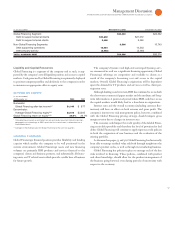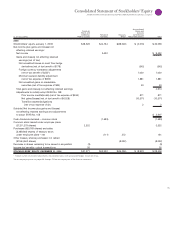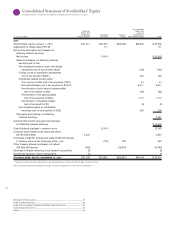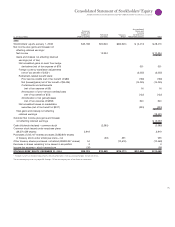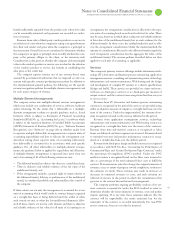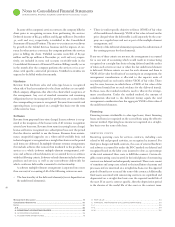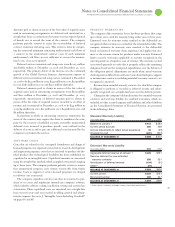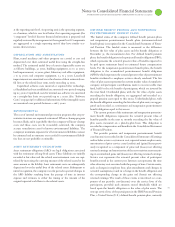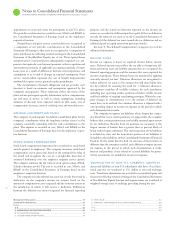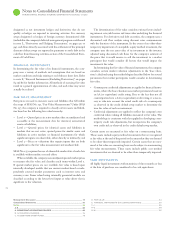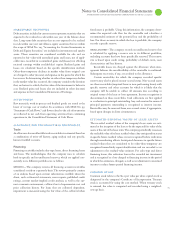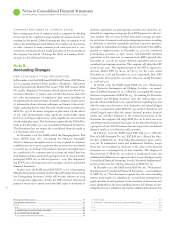IBM 2008 Annual Report Download - page 69
Download and view the complete annual report
Please find page 69 of the 2008 IBM annual report below. You can navigate through the pages in the report by either clicking on the pages listed below, or by using the keyword search tool below to find specific information within the annual report.
Notes to Consolidated Financial Statements
INTERNATIONAL BUSINESS MACHINES CORPORATION and Subsidiary Companies
benefit sufficiently separable from the product sale whose fair value
can be reasonably estimated, such payments are recorded as a reduc-
tion of revenue.
Revenue from sales of third-party vendor products or services is
recorded net of costs when the company is acting as an agent between
the client and vendor and gross when the company is a principal to
the transaction. Several factors are considered to determine whether
the company is an agent or principal, most notably whether the com-
pany is the primary obligor to the client, or has inventory risk.
Consideration is also given to whether the company adds meaningful
value to the vendor’s product or service, was involved in the selection
of the vendor’s product or service, has latitude in establishing the
sales price or has credit risk.
The company reports revenue net of any revenue-based taxes
assessed by governmental authorities that are imposed on and con-
current with specific revenue-producing transactions. In addition to
the aforementioned general policies, the following are the specific
revenue recognition policies for multiple-element arrangements and
for each major category of revenue.
Multiple-Element Arrangements
The company enters into multiple-element revenue arrangements,
which may include any combination of services, software, hardware
and/or financing. To the extent that a deliverable in a multiple-
element arrangement is subject to specific guidance, such as, leased
hardware which is subject to Statement of Financial Accounting
Standards (SFAS) No. , “Accounting for Leases,” or software which
is subject to the American Institute of Certified Public Accountants
(AICPA) Statement of Position (SOP) No. -, “Software Revenue
Recognition,” (see “Software” on page ) on whether and/or how
to separate multiple deliverable arrangements into separate units of
accounting (separability) and how to allocate the arrangement con-
sideration among those separate units of accounting (allocation),
that deliverable is accounted for in accordance with such specific
guidance. For all other deliverables in multiple-element arrange-
ments, the guidance below is applied for separability and allocation.
A multiple-element arrangement is separated into more than one
unit of accounting if all of the following criteria are met:
•
The delivered item(s) has value to the client on a stand-alone basis;
• There is objective and reliable evidence of the fair value of the
undelivered item(s); and
• If the arrangement includes a general right of return relative to
the delivered item(s), delivery or performance of the undelivered
item(s) is considered probable and substantially in the control of
the company.
If these criteria are not met, the arrangement is accounted for as one
unit of accounting which would result in revenue being recognized
on a straight-line basis or being deferred until the earlier of when
such criteria are met or when the last undelivered element is deliv-
ered. If these criteria are met for each element and there is objective
and reliable evidence of fair value for all units of accounting in an
arrangement, the arrangement consideration is allocated to the sepa-
rate units of accounting based on each unit’s relative fair value. There
may be cases, however, in which there is objective and reliable evidence
of fair value of the undelivered item(s) but no such evidence for the
delivered item(s). In those cases, the residual method is used to allo-
cate the arrangement consideration. Under the residual method, the
amount of consideration allocated to the delivered item(s) equals the
total arrangement consideration less the aggregate fair value of the
undelivered item(s). The revenue policies described below are then
applied to each unit of accounting, as applicable.
Services
The company’s primary services offerings include information tech-
nology (IT) datacenter and business process outsourcing, application
management services, consulting and systems integration, technology
infrastructure and system maintenance, Web hosting and the design
and development of complex IT systems to a client’s specifications
(design and build). These services are provided on a time-and-mate-
rial basis, as a fixed-price contract or as a fixed-price per measure of
output contract and the contract terms range from less than one year
to over years.
Revenue from IT datacenter and business process outsourcing
contracts is recognized in the period the services are provided using
either an objective measure of output or a straight-line basis over the
term of the contract. Under the output method, the amount of rev-
enue recognized is based on the services delivered in the period.
Revenue from application management services, technology
infra structure and system maintenance and Web hosting contracts is
recognized on a straight-line basis over the terms of the contracts.
Revenue from time-and-material contracts is recognized as labor
hours are delivered and direct expenses are incurred. Revenue related
to extended warranty and product maintenance contracts is recog-
nized on a straight-line basis over the delivery period.
Revenue from fixed-price design and build contracts is recognized
in accordance with SOP No. -, “Accounting for Performance of
Construction-Type and Certain Production-Type Contracts,” under
the percentage-of-completion (POC) method. Under the POC
method, revenue is recognized based on the labor costs incurred to
date as a percentage of the total estimated labor costs to fulfill the
contract. If circumstances arise that change the original estimates of
revenues, costs, or extent of progress toward completion, revisions to
the estimates are made. These revisions may result in increases or
decreases in estimated revenues or costs, and such revisions are
reflected in income in the period in which the circumstances that
gave rise to the revision become known by management.
The company performs ongoing profitability analyses of its ser-
vices contracts accounted for under the POC method in order to
determine whether the latest estimates of revenue, costs and profits
require updating. If at any time these estimates indicate that the
contract will be unprofitable, the entire estimated loss for the
remainder of the contract is recorded immediately. For non-POC
service contracts, losses are recorded as incurred.


